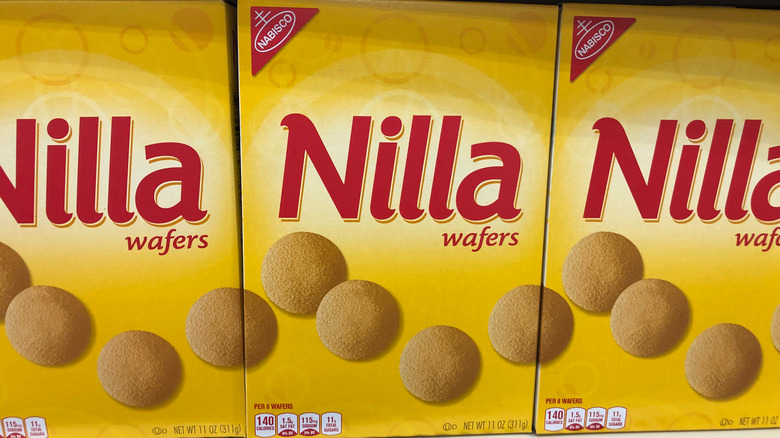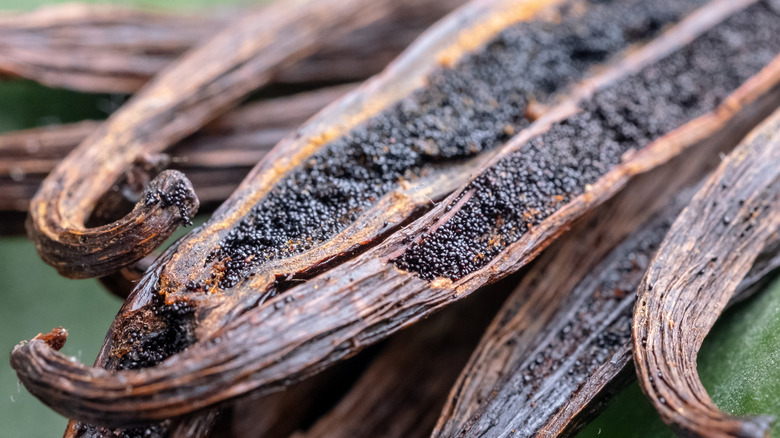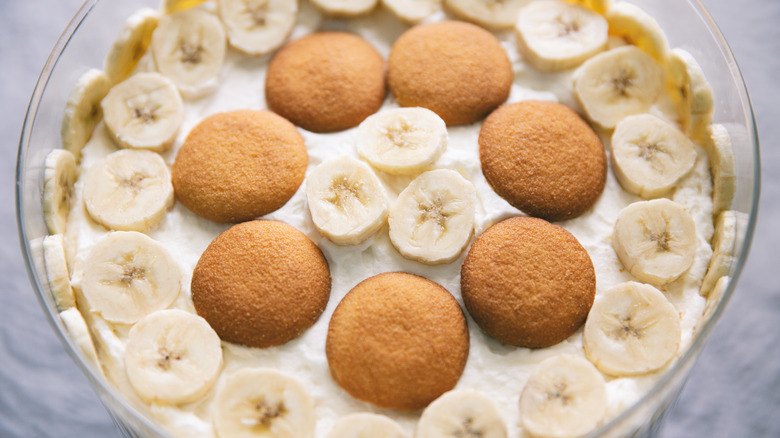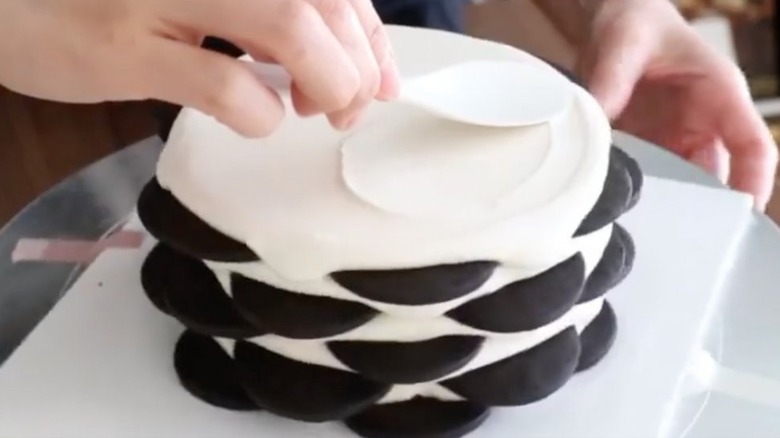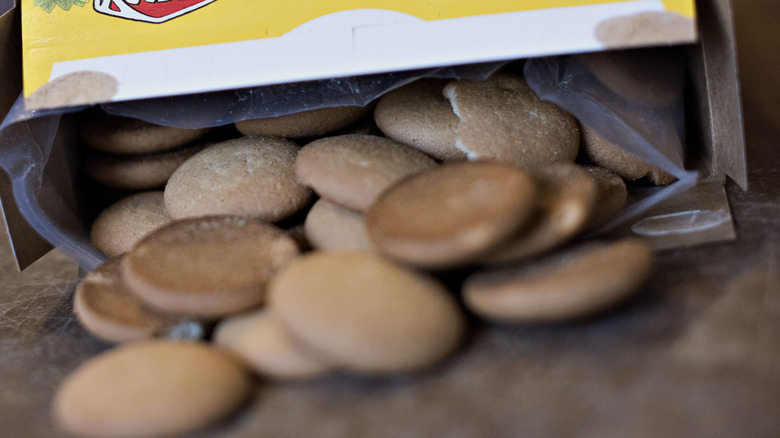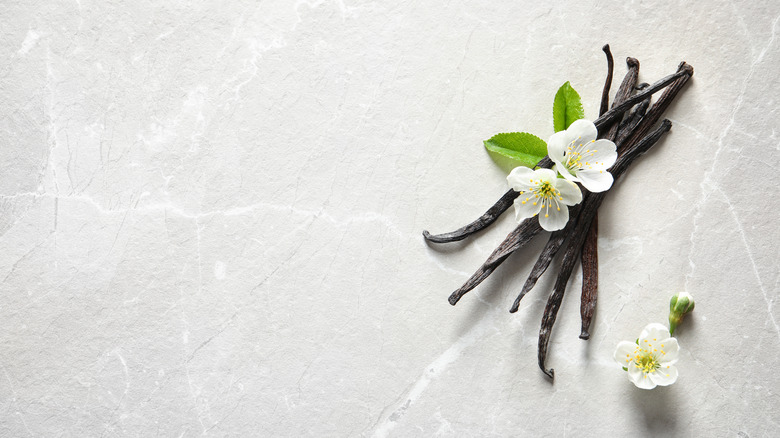The Untold Truth Of Nilla Wafers
"Vanilla" flavor is often scoffed at for being "boring" or just plain "common" (via Scientific American). But the truth of the matter is, there's a really good chance that you love vanilla — and it may even be your favorite flavor. After all, year after year, vanilla is America's favorite ice cream flavor, despite the barrage of new, highly creative, and highly tempting flavors that is constantly being introduced by ice cream makers (via Dairy Reporter). As far as cookies go, although chocolate chip often tops "favorite cookies" lists in this country, it's worth noting not only that chocolate chip cookies have what is, essentially, a vanilla cookie base, but also that plenty of people prefer their chocolate chip cookies chipless (via Instacart). All of which is to say, we think it's a safe bet that you might have a bit of a soft spot in your heart for Nabisco's crispy vanilla-flavored Nilla wafers.
And how do we know this? Well, put it this way: Nilla wafers have an estimated annual growth rate of 45.8%, according to Tastewise. To put that into perspective, consider that the overall global cookies market (i.e. all cookies sold all over the world), which was valued at $30.62 billion in 2018, has been projected to expand at a compounded actual growth rate of 5.3% between 2019 and 2025. So, yeah, we see you, but there's nothing to be ashamed of. In fact, read on for the untold truth of Nabisco Nilla wafers.
The Nilla part came from vanilla beans
Vanilla wafers had already become a beloved American cookie that you could purchase from the bakery by the middle of the 19th century. However, the recipe for the Nilla wafers that you know and, presumably, love was devised by a man named Gustav A. Mayer, a confectioner from New York, who sold it to the National Biscuit Company soon after that company was formed via several mergers of smaller bakeries. In fact, the National Biscuit Company's very first use of the brand name "Nabisco," the shortened version of "National Biscuit Company" that we know today, was in connection with selling the first Nilla wafers starting that same year, according to 24/7 Wall Street. The only thing was that they weren't called "Nilla" wafers yet.
When first marketed, Nillas were known as "Nabisco Vanilla Wafers." It wasn't until 1967 that they were rebranded by Nabisco (which is now owned by Mondelez, via the Mondelez company history) as "Nilla" wafers. If you're wondering why these cookies are referred to as "wafers," it's because "wafers" are a type of cookie, which is defined as a "small sweet cake" (via Collins Dictionary). Specifically, Collins defines a wafer is a "thin crisp" cookie (or "biscuit," as they say on the continent, via Bread, Cakes, and Ale).
Nilla Wafers helped make Southern banana pudding what it is today
True or false: Southern banana pudding (a sweet and gooey icebox concoction made from vanilla wafers, fresh bananas, and custard) would not exist but for Nabisco Nilla wafers.
Spoiler alert: it's a trick question. Although Southern banana pudding has come to be pretty much synonymous with Nilla wafers, the fact is that what we think of today as traditional Southern banana pudding existed even before Nabisco started marketing its Vanilla Wafers in 1898. However, it wasn't made with vanilla wafers, but rather sponge cake or lady fingers. (via Serious Eats). And some 19th century recipes used gelatin or tapioca instead of custard. Others used meringue on top. So, when did Nilla wafers get in on the act?
During the 1940s, Nabisco began selling its boxes of Nabisco Vanilla Wafers (they were still called that then) with a recipe for a banana pudding made with Nabisco Vanilla Wafers, in place of the cake or gelatin or whatever it was people were (misguidedly) putting in theirs. This particular version of banana pudding quickly rose to popularity in the South, according to 24/7 Wall Street. That's why it's now known as "Southern" banana pudding, despite that there is evidence that the first printed recipe for banana pudding came from New England (via Serious Eats).
Nilla wafers can be used in lots of ways that aren't Southern banana pudding
Although Nabisco Nilla wafers are probably what comes to mind first when you're putting together your shopping list for your homemade traditional Southern banana pudding, that is far from the only way to use Nilla wafers. First of all, it goes without saying that Nilla wafers make a delicious milk-and-cookies snack that's so simple and no-frills, you might be able to tell yourself you've made a healthy choice (and compared to some of the other snacks you might be having, it's a fair thing to tell yourself).
But Nilla wafers are also fantastic as a pie crust in place of graham cracker crumbs. And since it's more difficult now to get your hands on Nabisco's famous chocolate wafers (via AskingFact), which are the key ingredient in the classic "icebox cake," why not use Nilla wafers instead? There's certainly no shortage of them at this point in time (via Nabisco).
Here's how Nilla wafers stack up to other vanilla wafers
The question you very well might be asking right about now is "why does all the vanilla wafer glory go to Nabisco Nilla wafers?" After all, there are many other brands of vanilla wafers out there. However, it was Nabisco who put the Nilla wafer-based Southern banana pudding recipe on its box back in the 1940s, and it appears that people do care about tradition — or at least, if it ain't broke, why fix it? But that might only account for the Nilla wafers that get turned into banana pudding. What about the rest?
The answer appears to be that not all vanilla wafers taste the same, and not all vanilla wafers have the same texture. And, although the evidence is strictly anecdotal, it also appears that Nilla wafers have done better in taste tests. For example, in a side-by-side comparison between Stauffer's "vanilla wafers" and Nabisco Nillas, the latter was the "clear winner," according to Second Rate Snacks, which "noted the pleasant vanilla aroma right from opening" the Nillas, as well as the "soft crunch" and "melt in your mouth" sensation. By comparison, the Stauffer's wafers were "too rough and dry with a poor quality vanilla flavor."
On the other hand, Nilla wafers don't come in rainbow colors like some of the competing brands such as Keeblers have from time-to-time (via Fortune). On the other other hand, Nilla wafers are available in mini-cookie size, which makes them super-fun and great for the kiddies.
Are Nilla wafers actually made with vanilla, though?
As common as vanilla may be as a flavor nowadays, there was once a point in history when it was a rare commodity, according to Scientific American. That's because, at the time, things that were flavored "vanilla" had to be made with actual vanilla beans, or, at the very least, extract of vanilla beans. Of course, that hasn't been the case since the turn of the 20th century, which is when chemists invented "vanillin," which can be manufactured without a lick of actual vanilla bean. Rather, Scientific American reports that vanillin can be "synthesized variously from pine bark, clove oil, rice bran, and lignin." And since that time, "of the roughly 18,000 metric tons of vanilla flavor produced annually, about 85% is vanillin synthesized from the petrochemical precursor guaiacol," with the rest from lignin.
You can read more about the difference between vanilla and vanillin, but we're going to just come right out and say it: Nilla wafers contain no actual vanilla. That doesn't mean they don't taste delicious and make a mean Southern banana pudding. But there ya go. Now ya know.
